Now that power tools are the standard for home DIY projects, hand-sawing might seem outdated. However, the right kind of handsaw can be perfect for small jobs like cutting moldings or trimming wood while on a ladder. Once you get the hang of them, these saws can be easier to control and even more accurate than some power saws. Keep reading to learn more about the different types of hand saws, how to pick the right one for your project, and when to choose a hand saw over a power saw.
Understanding Handsaw Ripping and Crosscutting
Traditionally, saw teeth have been designed to cut either with the grain (ripping) or across it (crosscutting). Most Western-style saws cut on the push stroke and have different-shaped teeth from Japanese-style saws, which cut on the pull stroke with a thinner blade.
These days, however, manufacturers make hybrid saws that can both rip and crosscut. Some cut on the push stroke and some on the pull.
What Types of Handsaws Are There?
Handsaws come in different styles, each designed for specific cutting tasks. Understanding these differences will help you choose the right saw for your project and get the best results. Learn more about the various types of handsaws below.
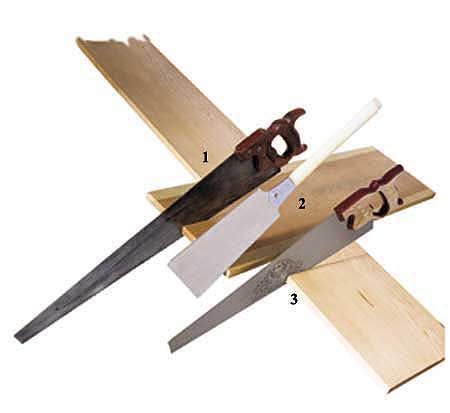
1) Western-style ripsaw: These saws are best for cutting solid wood with the grain. Most types of Western saws cut on the push stroke.
2) Ryoba saw: Not to be confused with the power tool brand Ryobi, these Ryoba saws are best for cutting solid wood, both with and across the grain. One edge has wide teeth for ripping, the other narrow teeth for crosscutting. The thin blade cuts on the pull stroke.
3) Western-style crosscut saw: These are best for cutting solid wood across the grain, as in studs, joists, and rafters.
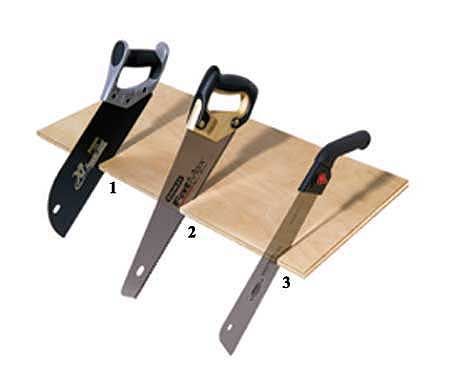
1) Plywood saw: These saws are best for cutting plywood and other sheet materials, including laminates, used for underlayment, sheathing, flooring, and the like. They’re not meant for cutting solid wood.
2) Toolbox saw: This general-purpose saw is perfect for ripping and crosscutting lumber, plywood, particleboard, and plastic.
3) Utility saw: This type of saw is great for ripping and crosscutting plywood, particleboard, and softwood lumber for framing or trim.
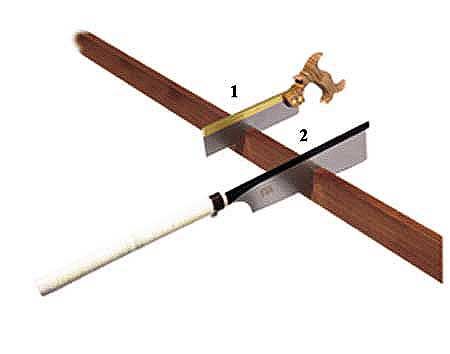
Fine Cutter Handsaws
1) Dovetail saw: This saw is great for fine cuts in narrow wood, as when trimming moldings, making joints, or repairing furniture. Also good for cutting plastic, including laminate.
2) Dozuki saw: These saws are best for very fine finish cuts for cabinetry and furniture-making.
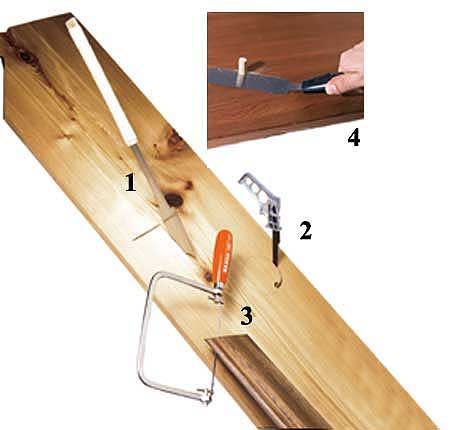
1) Azebiki saw: These saws are best for straight-sided plunge cuts in the middle of a board for electrical boxes, switches, etc. When using these saws, no starter hole is necessary.
2) Keyhole saw: These saws are great for curved holes in plywood or solid wood for pipes or ducts through walls, roofs, and built-in cabinets. You need to drill a starter hole when using these saws.
3) Coping saw: This type of saw is perfect for cutting curves and intricate shapes in solid wood, plywood, or plastic. The blade is reversible to cut on the push or pull stroke.
4) Flush-cutting saw: This saw is best for cutting plugs, dowels, and tenons flush with the surrounding surface. Use it for delicate work on veneers and other thin materials. It has a very flexible blade that’s made to cut in either direction.
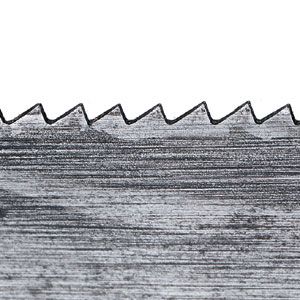
Choosing the Right Handsaw for Your Project
Having the right tool for the job is crucial for getting clean cuts in your DIY projects. Consider the following factors when choosing what saw to use.
Rip Saws vs. Crosscut Saws
Rip saws are designed to cut along the grain of the wood, while crosscut saws are meant for cutting across the grain. Rip saws have fewer, larger teeth that act like chisels to remove wood fibers. Crosscut saws have more teeth with beveled edges to sever wood fibers cleanly. For general-purpose use, consider a hybrid saw that can handle both ripping and crosscutting.
Handle Type
Another important factor is the type of handle. Traditional straight handles usually offer better control, while pistol-grip handles can provide more leverage and comfort, especially for extended use.
Teeth Per Inch
Saw teeth are measured by the number of tooth points per inch (TPI). The fewer the teeth, the more aggressive the blade for faster, rougher cuts. On the other hand, more teeth are better for finer, more precise cuts. Most saw teeth have “set,” which means they tilt alternately left and right to make a saw cut (kerf) that’s wider than the blade, keeping it from binding.
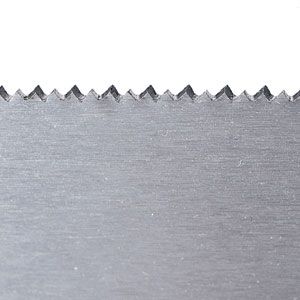
Handsaw vs. Power Saw: When To Choose Each
While power saws have their place, handsaws offer unique advantages in certain situations. If you’re unsure about when to use each, consider the applications below.
Advantages of Handsaws
Handsaws are quiet, portable, and don’t require electricity. They’re ideal for small, precise cuts in tight spaces where a power saw might not fit. They’re often safer for beginners and allow for tactile feedback that power saws can’t provide, making them perfect for fine, detailed work.
Situations Where Power Saws Excel
Power saws are preferable for large-scale projects, repetitive cuts, or when working with very hard materials. They can save time and effort on big jobs but may lack the finesse needed for detailed work. For example, tasks like cutting large sheets of plywood or making repetitive cuts for framing a house are much more efficient with a power saw.
Balancing Both Tools
For most woodworkers, a combination of both handsaws and power saws will provide the best versatility. Handsaws offer precision and control, while power saws deliver speed and power. If you have both on hand, you’re guaranteed to have the right tool for the job, no matter your task.
Safety Precautions When Using Handsaws
While handsaws are generally safer than power tools, it’s still important to follow proper safety practices to avoid injury and ensure a successful project. Before starting any DIY projects with handsaws, refer to the Occupational Safety and Health Administration’s guide on handheld saws.
Proper Hand Placement
Always keep your hands and fingers away from the path of the saw blade. Use clamps or a vise to secure your workpiece whenever possible, rather than holding it with your free hand. This reduces the risk of slipping and accidental cuts.
Securing Your Workpiece
Ensure your workpiece is firmly supported and won’t shift during cutting. Use sawhorses, a workbench, or clamps to keep the material stable and prevent binding of the saw blade.
Using Protective Gear
Wear safety goggles to protect your eyes from sawdust and splinters. Additionally, consider wearing gloves to protect your hands, although some woodworkers prefer to go without gloves for better control.
Understanding Your Limits
Recognize when a task may be too challenging and consider seeking help or utilizing more specialized tools. Overextending yourself or using a tool improperly can lead to mistakes or injuries.
Where to Find Handsaws
Ripsaw:
TOH private collection
Ryoba saw:
Model #610
Hida Tool Inc.
Berkeley, CA
800-443-5512
Western crosscut saw:
26-inch PAX Crosscut Saw
Thomas Flinn & Co.
Sheffield, England; available in U.S. through Garrett Wade
800-221-2942
Plywood saw:
Model #324 12-inch Veneer Saw
Bahco Group
Scranton, PA
570-341-9500
Toolbox saw:
FaxMax #20-045
Stanley Tools
New Britain, CT
800-262-2161
Utility saw:
SharkSaw #10-2312 General Carpentry Saw 12-inch
Shark Corp.
Wilmington, CA
800-891-7855
Dovetail saw:
Carcass Saw (crosscutting), Independence Saw (rip cutting)
Lie-Nielsen Toolworks
Warren, ME
800-327-2520
Dozuki saw:
Takumi #10-2610
Shark Corp.
Azebiki saw:
Takumi #10-2920 Mid Panel Saw 3 1/2-inch
Shark Corp.
Flush-cutting saw:
Veritas #05K36.01
Lee Valley Tools
800-267-8735
Coping saw:
Model #301, 6.5-inch
Bahco Group
Keyhole saw:
Stanley #15-275 pistol-grip 4-way keyhole saw
Stanley Tools
Our thanks to:
Robert Larson Company Inc., supplier of fine woodworking tools
San Francisco, CA
800-356-2196

